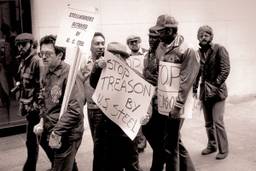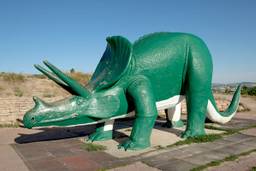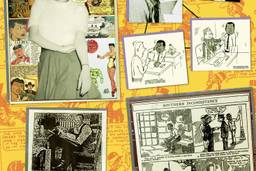
Only by understanding the sources of conservative political power can we hope to advance progressive interests. Two recent books by two distinguished scholars seek to illuminate the topic — that is, to explain the failures of the liberal-labor alliance during and after the New Deal, and the persistent power of conservative, even reactionary, forces. For sociologist G. William Domhoff, author of The Myth of Liberal Ascendancy: Corporate Dominance from the Great Depression to the Great Recession, the culprit was, and is, big business. For historian-cumpolitical scientist Ira Katznelson, author of Fear Itself: The New Deal and the Origins of Our Time, the key factor was, and is, the power wielded in Congress by Southern representatives.
Domhoff sets out to destroy a myth he believes historians have created: that a liberal-labor alliance dominated domestic policy-making for a four-decade stretch, during the New Deal, the Fair Deal, the New Frontier and the Great Society. As Domhoff tells it, while the early New Deal years may have offered brighter prospects for the liberal-labor coalition than subsequent years, even then corporate leaders from such companies as GE, U.S. Steel and Eastman Kodak greatly influenced policy-making. During World War II, they formed the Committee for Economic Development (CED), which Domhoff says dominated economic policy formation until the early 1970s, after which corporate liberals allied with reactionary executives of the later CEO cabal, the Business Roundtable, to promote neoliberalism. He maintains that before the switch to more reactionary policies, the moderate corporate executives shaped Social Security, labor policy, industrial relations, monetary and fiscal policy (forms of conservative Keynesianism), environmental protection (the EPA under Nixon), occupational safety (OSHA) and, of course, economic deregulation to their own advantage— while gaining the consent of those they dominated.
Domhoff may think that he is telling a new story that shreds governing myths, but for two decades historians have been telling the same story — a tale of an America turning increasingly conservative after the “Roosevelt revolution”—without relying upon the hidden hand of the CED. Domhoff hammers on this single note without sufficient recognition of the liberals and labor advocates who shaped the most lasting reforms of the New Deal.
Katznelson’s text covers a shorter span of time, 1933 to 1953, but on a far more sweeping canvas. If he does not uncover a notably different New Deal, his analysis of its guiding forces is more convincing. He uses a wider geographic lens than Domhoff, seeing the United States embedded in a larger world that influenced the making of New Deal policy. His primary organizing principle is the era’s overwhelming sense of dread or fear, precipitated first by the Great Depression, heightened by the butchery of World War II and intensified by the nuclear clouds that hung over humankind in the aftermath of Hiroshima. Though Franklin Roosevelt counseled citizens to stow away their fears in 1933, Katznelson says that such advice was impossible to follow in a world of economic misery, total war and potential thermonuclearannihilation. For him, fear played a greater role than the CED in shaping New Deal America, causing citizens and leaders to seek ever greater security at home and abroad.
Overall, however, Katznelson laudsthe New Deal as a uniquely U.S. response to the collapse of capitalism. He describes how the United States regulated capitalism by creating a more centralized and powerful government, empowering working people through the validation of mass industrial unions, and defending — and even advancing — basic democratic political principles.
In Katznelson’s version of New Deal history, Southern power in Congress regulated the flow of legislation and determined the limits of reform. Southerners formed a vital bloc of Democratic legislators and chaired key committees in both houses of Congress.
Early in the New Deal, the South— which was the nation’s poorest region even before the Depression worsened its misery — embraced New Deal financial largesse, welcoming agricultural subsidies and public works programs as godsends, especially the Tennessee Valley Authority’s promise of cheap power and rural electrification. The region’s New Deal gains were so great that Southern legislators even tolerated federal sanction for unions and collective bargaining, so long as they could ensure that most New Deal programs were administered locally.
Southern support, however, depended on excluding from New Deal protections the African-American agricultural and domestic workers who formed the bulk of the Southern labor force, thus leaving the Southern racial order untouched. The moment that the New Deal threatened to upset the Southern “way of life” and its labor market, as when the Supreme Court upheld the Wagner Act in 1937 and Congress passed the Fair Labor Standards Act in 1938, Southern Congress members rebelled and formed an alliance with Northern Republicans that set firm limits to further national reform. Beginning in 1938, a conservative congressional coalition controlled the legislative process.
The conservative alliance proved imperfect, however, because the South remained poor and rural. Hence, Southern Democrats supported another round of agricultural subsidies under Truman’s Fair Deal, as well as infrastructure expenditures and federal support for housing and public health (unlike their Republican allies, who preferred a parsimonious government based on low taxes and minimal spending). Though eventually Southern legislators shifted from the Democratic to the Republican Party, this vexed dynamic still persists, or in Katznelson’s words:
This two-sided state, a state characterized by democratic advantages yet marked by antidemocratic pathologies, continues to constitute the world Americans inhabit. This, ultimately, is the legacy of the New Deal’s Southern cage.
Today that cage is even tighter, as Southern legislators continue to dominate Congress, and as Republicans, rather than Democrats, prefer limited government, low taxes, parsimonious expenditure, weak or absent unions, and a racially segmented, lowwage labor force. Southern conservatives— not sophisticated corporate executives linked to the CED — have called the tune in national politics,and continue to do so. The Tea Party’s agenda may be partly funded by the antediluvian Koch brothers, the antithesis of corporate liberals, but its mass participants dance to tunes first played by the Southern Democratic lawmakers.

I hope you found this article important. Before you leave, I want to ask you to consider supporting our work with a donation. In These Times needs readers like you to help sustain our mission. We don’t depend on—or want—corporate advertising or deep-pocketed billionaires to fund our journalism. We’re supported by you, the reader, so we can focus on covering the issues that matter most to the progressive movement without fear or compromise.
Our work isn’t hidden behind a paywall because of people like you who support our journalism. We want to keep it that way. If you value the work we do and the movements we cover, please consider donating to In These Times.







